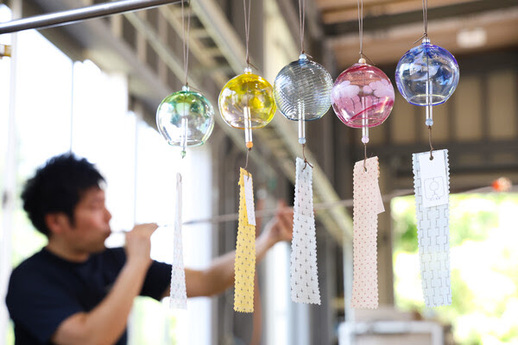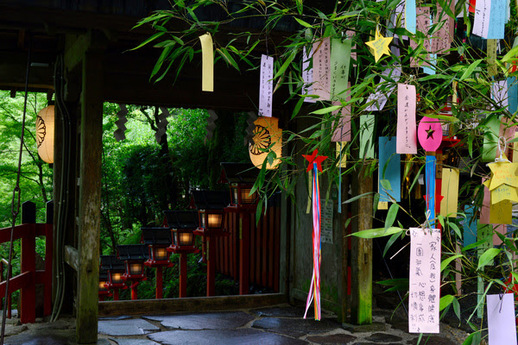2024.07.11
伝検通信(メルマガ)週刊メールマガジン「伝検通信」 第15号
週刊メールマガジン「伝検通信」第15号をお届けします。
今号のメインコンテンツは、本格的な夏を前に、能登半島地震からの早期復興の願いとともに制作される「のと風鈴」を紹介する動画です。画像をクリックすると動画のページにジャンプします(再生時間は1分26秒)。
「クイズで肩慣らし」は前回クイズの答え・解説と、食文化・歳時記分野からの出題です。
メルマガ登録した方の中から、抽選で100人に公式テキストをプレゼントするキャンペーンも引き続き実施中です! ぜひお近くの方にメルマガ登録をご案内ください。
伝検公式テキスト
https://bookpub.jiji.com/book/b648563.html
目次
・ 高く澄んだ音色で涼しさを=「のと風鈴」生産急ピッチ
・ 「クイズで肩慣らし」第15回(食文化・歳時記)=「七夕」
・ 伝検協会だより
高く澄んだ音色で涼しさを=「のと風鈴」生産急ピッチ

のと風鈴=画像をクリックすると動画のページにジャンプします(時事通信提供)
繊細な優しい音色で涼しさを感じられる夏の風物詩、風鈴―。本格的な夏を前に、石川県七尾市の能登島ガラス工房で「のと風鈴」の生産が急ピッチで続いている。
ピンク、緑など色とりどりの、のと風鈴は高く澄んだ音色が特徴で、同工房やインターネット通販で販売されている。中でも、七尾湾に浮かぶ能登島の自然豊かな海の色をイメージして作られた青色の「能登藍(のとブルー)」が人気だ。
風受けは伝統的な石川県無形文化財の高級麻織物「能登上布(のとじょうふ)」。絣(かすり)模様が涼しげな雰囲気を演出する。
能登半島地震では、工房の溶解炉などが破損。職人の高橋真人さんは地震の影響について、「能登島のお土産屋や施設の多くは営業ができておらず、観光客は戻ってきていない」と指摘する。日々、ガラスに息を吹き込みながら願うのは早期復興。「のと風鈴は一つ一つの音色が違う。実際に島を訪れ、風鈴に触れたり音を聞いたりして、気に入ったものを探してほしい」と語っている。
能登上布とは
能登上布は麻糸を使用した手織りの織物で、日本の五大上布の一つとされる。細やかな絣(かすり)模様が特徴で、軽くて通気性が良く、麻独特のシャリ感や、さらりとした肌触りが魅力。約2000年前に崇神天皇の皇女が中能登地方に滞在した際に、機織りを教えたのが始まりといわれている。1960年には石川県の無形文化財(工芸技術)に指定された。
「クイズで肩慣らし」第15回(食文化・歳時記)=「七夕」
~伝検公式テキスト(9月20日先行発売予定)のジャンルごとに出題します~

貴船神社(京都市左京区)の七夕飾り
第15回
問題:7月7日の「七夕」は五節句の一つ。五節句にはそれぞれ「行事食」があります。行事食とは、行事やお祝いの日に食べる特別な料理のことをいいます。七夕の行事食は何でしょう。
【前回の答えと解説】
問題:代表的な夏の涼菓子の一つで、 みずみずしく喉越しがよい食感の「水羊羹(みずようかん)」。 古くから冬に水羊羹を食べる習慣があり、 冬の風物詩として親しまれている県はどちらでしょう。
答え:福井県
解説:福井県では、毎年11月に入ると土産屋や菓子屋にずらりと水羊羹が並びはじめ、県民は冬の訪れを感じます。福井の水羊羹のルーツは諸説あり、江戸時代に関西へ年季奉公に出ていた少年が年末の帰省時に持ち帰った小豆で作ったという説、また、持ち帰った羊羹を水と寒天を加え炊き直して食べたという説などがあります。糖度が低い水羊羹は保存が利かず、福井の冬の厳しい寒さが寒天を固めるのに適していたことなどから、冬場が旬になったと言われています。
伝検協会だより
伝検公式テキストの発売日について、諸般の事情により、お知らせしていた9月1日からやや遅れ、9月20日に先行発売、書店やネット書店での発売は10月2日に変更いたします。ご予約済みの方や購入をご検討されている方にはご迷惑をお掛けし、お詫び申し上げます。併せて、第1回伝検2級・3級試験のお申し込みも受付開始を9月20日に変更します。なお、受験期間は11月29日~来年1月31日で変更ありません。また、当メルマガ登録者への公式テキストのプレゼント(抽選で100人)は締め切りを7月末から8月末まで延長します。
編集後記
伝検通信第15号をお届けしました。蒸し暑い夏の日に風鈴の音を聞くと涼しく感じられます。一説には、音そのものに高周波や倍音が含まれリラックス効果があったり、風の存在を音として認識できたりするからとのことですが、暑い日々を乗り切る先人の知恵でもあったと思います。風鈴やセミの鳴き声が聞こえてくると本格的な夏到来です。
カテゴリー: 伝検通信(メルマガ)





